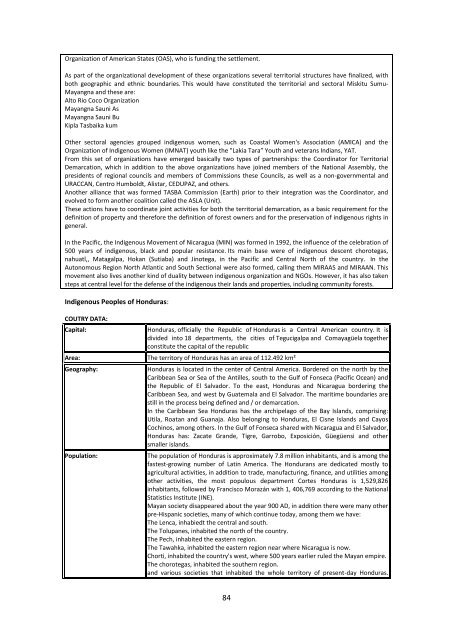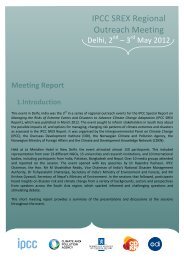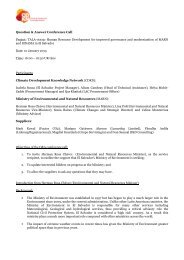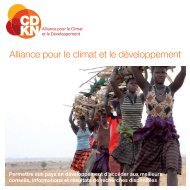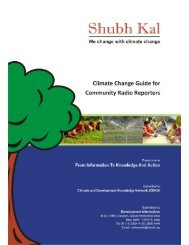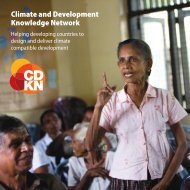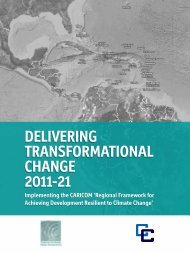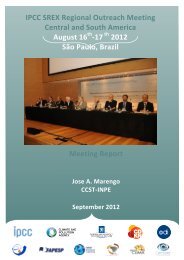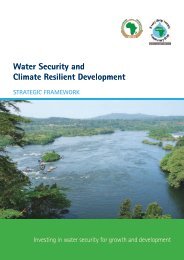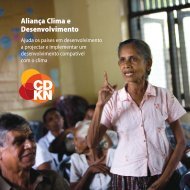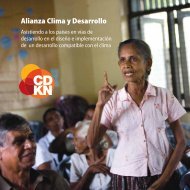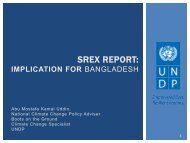Organization of American States (OAS), who is funding the settlement.As part of the organizational development of these organizations several territorial structures have finalized, withboth geographic and ethnic boundaries. This would have constituted the territorial and sectoral Miskitu Sumu-Mayangna and these are:Alto Rio Coco OrganizationMayangna Sauni AsMayangna Sauni BuKipla Tasbaika kumOther sectoral agencies grouped indigenous women, such as Coastal Women's Association (AMICA) and theOrganization of Indigenous Women (IMNAT) youth like the "Lakia Tara” Youth and veterans Indians, YAT.From this set of organizations have emerged basically two types of partnerships: the Coordinator for TerritorialDemarcation, which in addition to the above organizations have joined members of the National Assembly, thepresidents of regional councils and members of Commissions these Councils, as well as a non-governmental andURACCAN, Centro Humboldt, Alistar, CEDUPAZ, and others.Another alliance that was formed TASBA Commission (Earth) prior to their integration was the Coordinator, andevolved to form another coalition called the ASLA (Unit).These actions have to coordinate joint activities for both the territorial demarcation, as a basic requirement for thedefinition of property and therefore the definition of forest owners and for the preservation of indigenous rights ingeneral.In the Pacific, the Indigenous Movement of Nicaragua (MIN) was formed in 1992, the influence of the celebration of500 years of indigenous, black and popular resistance. Its main base were of indigenous descent chorotegas,nahuatl,, Matagalpa, Hokan (Sutiaba) and Jinotega, in the Pacific and Central North of the country. In theAutonomous Region North Atlantic and South Sectional were also formed, calling them MIRAAS and MIRAAN. Thismovement also lives another kind of duality between indigenous organization and NGOs. However, it has also takensteps at central level for the defense of the indigenous their lands and properties, including community forests.Indigenous Peoples of Honduras:COUTRY DATA:Capital:Area:Geography:Population:Honduras, officially the Republic of Honduras is a Central American country. It isdivided into 18 departments, the cities of Tegucigalpa and Comayagüela togetherconstitute the capital of the republicThe territory of Honduras has an area of 112.492 km²Honduras is located in the center of Central America. Bordered on the north by theCaribbean Sea or Sea of the Antilles, south to the Gulf of Fonseca (Pacific Ocean) andthe Republic of El Salvador. To the east, Honduras and Nicaragua bordering theCaribbean Sea, and west by Guatemala and El Salvador. The maritime boundaries arestill in the process being defined and / or demarcation.In the Caribbean Sea Honduras has the archipelago of the Bay Islands, comprising:Utila, Roatan and Guanaja. Also belonging to Honduras, El Cisne Islands and CayosCochinos, among others. In the Gulf of Fonseca shared with Nicaragua and El Salvador,Honduras has: Zacate Grande, Tigre, Garrobo, Exposición, Güegüensi and othersmaller islands.The population of Honduras is approximately 7.8 million inhabitants, and is among thefastest-growing number of Latin America. The Hondurans are dedicated mostly toagricultural activities, in addition to trade, manufacturing, finance, and utilities amongother activities, the most populous department Cortes Honduras is 1,529,826inhabitants, followed by Francisco Morazán with 1, 406,769 according to the NationalStatistics Institute (INE).Mayan society disappeared about the year 900 AD, in addition there were many otherpre-Hispanic societies, many of which continue today, among them we have:The Lenca, inhabiedt the central and south.The Tolupanes, inhabited the north of the country.The Pech, inhabited the eastern region.The Tawahka, inhabited the eastern region near where Nicaragua is now.Chorti, inhabited the country's west, where 500 years earlier ruled the Mayan empire.The chorotegas, inhabited the southern region.and various societies that inhabited the whole territory of present-day Honduras.84
Indigenous Population:IDH 241 In 2007, of the 0.732Internationalconventions signed withindigenous peoples aroundthe country 242 :Political system:Main Economy andSectors 243 :From Chiapas to Costa Rica about 5 million people inhabited.Faced with the loss of native languages as the Lenca or Chol and endangeredlanguages that exist such as Payas, the Constitution considered necessary by Section172 that "all wealth of anthropological, archaeological, historical and artistic Hondurasis part of the nation's cultural heritage. The law shall establish standards as basis forconservation, restoration, maintenance and restitution, if any. It is the duty of allHondurans to ensure the protection and prevent theft. Likewise, the Constitution iscommitted to preserving and enhancing "the native cultures and the genuineexpressions of national folklore, folk art and crafts 239 .Laws and decrees relating to indigenous peoples in Honduras 240 :14/11/1966 Education Law Decree no. 7910/01/1974 Law of the Honduran Forest Development Law Decree no. 10314/09/1989 Higher Education Law Decree no. 14206/04/1992 Modernization Act and the Agricultural SectorDevelopment Decree no. 31Agreement No. 19/10/1992. 2124 regulations governing the award of land inthe Land Reform1993 Public Ministry Law Decree no. 22827/05/1993 General Environmental Law Decree no. 10403/08/1994 Agreement No. EP 0 719-94 recognition by Honduras asa multicultural and multiethnic that require institutionalization ofIntercultural Bilingual Education07/01/1 997. No. PCM-00321/07/1997. Agreement No. 110 Building Commission to prepare draft law toregulate issues related to indigenous and tribal population.24/12/1998 General Mining Law Decree no. 292Promulgationof theConstitutionForm ofgovernment11/1/1982 State rightsovereign,constitutedas free republic,democratic andindependent(Preamble 1)Convention107 (1957)Not ratifiedConvention169OIT(1989)ratified28/3/1995Hierarchy ofInternationalConventionsTreatiesconventionsare aboveof the Act(art.16, 18)Article 4 of the Constitution of the Republic of Honduras states that «the formof government is republican, democratic and representative. Is exercised by threebranches: legislative, executive and judicial, independent and complementaryand non-subordinate relationships. It adds that the rotation in office of thePresident of the Republic is mandatory, and that violation of this policy constitutes acrime of treason.In Section 5, the same constitution says that, government must be based on theprinciple of participatory democracy which is derived from national integration, whichinvolves participation of all political sectors ... to ensure and strengthen Honduras'sprogress based on political stability and national reconciliation.In all departments of the republic there is a continuing productive activity inagriculture, livestock, fisheries, textiles, mining, among others.In 2006 the Honduran economy grew by 6%, one of the most outstanding in LatinAmerica, says a rising line which began in 2004 during the administration of PresidentRicardo Maduro, according to ECLAC's annual report.239 Wikipedia-Honduras: http://es.wikipedia.org/wiki/Honduras240 Honduras-UNHCR. Indigenous Peoples and Constitutional Rights in Latin America: An Overview. Cletus Gregor Barié, Cit: pag:374 www.acnur.org/biblioteca/pdf/6292.pdf241 Wikipedia-Human Development Index: http://es.wikipedia.org/wiki/%C3%8Dndice_de_desarrollo_humano242 Honduras-UNHCR. Indigenous Peoples and Constitutional Rights in Latin America: An Overview. Cletus Gregor Barié, Cit: pag:372 www.acnur.org/biblioteca/pdf/6292.pdf243 Wikipedia-Honduras,Economy: http://es.wikipedia.org/wiki/Honduras85
- Page 3 and 4:
Executive SummaryCentral America is
- Page 5 and 6:
Central is located in the "Ring of
- Page 7 and 8:
Study ContentAs an innovative theme
- Page 9 and 10:
that coexist in the universe. This
- Page 11 and 12:
Central America level, is the only
- Page 13 and 14:
of Mesoamerica has been explained a
- Page 15 and 16:
possesses effective cultural commun
- Page 17 and 18:
Additionally, to succeed and achiev
- Page 19 and 20:
eforestation, hydrological planning
- Page 21 and 22:
General thematic introduction on Cl
- Page 23 and 24:
Central American Governments should
- Page 25 and 26:
projected 109 conditions, changes o
- Page 27 and 28:
General introduction on the themati
- Page 29 and 30:
participatory manner, to address di
- Page 31 and 32:
Causes and complementary consequenc
- Page 33 and 34: Organizational and legal contextWhi
- Page 35 and 36: The three bodies within the SICA ar
- Page 37 and 38: Based on research of available info
- Page 39 and 40: SE-CONREDCivilProtectionSNETCCNISCO
- Page 41 and 42: Synergy model that displays the add
- Page 43 and 44: Added value of indigenous and local
- Page 45 and 46: They do not work in a separate mann
- Page 47 and 48: demand for agricultural raw materia
- Page 49 and 50: Amazon DIPECHO Project “Strengthe
- Page 51 and 52: Indigenous Knowledge on DisasterMit
- Page 53 and 54: The combination of indigenous andsc
- Page 55 and 56: Indigenous Skills and the mysticism
- Page 57 and 58: Weather forecast through indigenous
- Page 59 and 60: In various international convention
- Page 61 and 62: Recommended ReadingBennett, A., 200
- Page 63 and 64: ILO, 1993, Convenio sobre pueblos i
- Page 65 and 66: Local knowledgeIncludes people and
- Page 67 and 68: which are threatswith a certainprob
- Page 69 and 70: Appreciates and respects their orga
- Page 71 and 72: framework, without taking into acco
- Page 73 and 74: Currently Cacaopera ethnicity, alth
- Page 75 and 76: IDH 228 For 2007 is of 0.6999Politi
- Page 77 and 78: The Mayangnas are people who are de
- Page 79 and 80: Rights of detainees to receive info
- Page 81 and 82: Heritage Protection Article 128The
- Page 83: 19/09/1996 Law no. 230 Amendments a
- Page 87 and 88: Honduras, each has a different orig
- Page 89 and 90: MISQUITOS 248 :In 1996 there were 3
- Page 91: Internationalconventions signed wit


